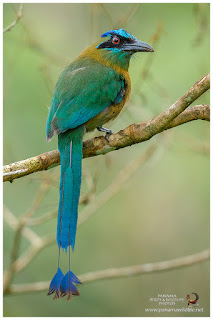Year 2016 end is near, and as we did last year we have selected the most special place of the year for us to make pictures. This year we have selected Paraíso, the Birding Paradise. A locality in Boquerón District, Chiriquí Province; the westernmost region of our country.
We returned in May 2016, for another short visit before we climbed the Barú Volcano, and in that occasion we were able to make the photos below.


Blue-throated Goldentail (Hylocharis eliciae) is a medium sized hummingbird with straight bill that is bright red, with a black tip, and that are broad at the base. The sexes are similar in pattern, but females are duller in color. Both males and females of this hummingbird boast striking golden tails. These hummingbirds live in both, humid and dry areas. In humid habitats, they prefer open woodlands and semi-open second growth; in drier regions, they occur in evergreen gallery forests. Throughout their range, they tend to frequent shady and open forest interiors where they forage at the mid and upper levels. It is found in Belize, Colombia, Costa Rica, El Salvador, Guatemala, Honduras, Mexico, Nicaragua, and Panama. It’s uncommon on Pacific slope from Azuero west to Chiriquí, and Darién province. Found in lower levels of forest and adjacent clearings.

Brown Violetear (Colibri delphinae) is a large hummingbird that breeds at middle elevations in the mountains in Central America, and western and northern South America (primarily the Andes and the Tepuis) with isolated populations on Trinidad and in the Brazilian state Bahia. Lacking the bright gaudy greens of other members of the genus, the overall brown plumage and bright violet auriculars make the Brown Violetear one of the most distinctive hummingbirds. This is a species of humid evergreen forest, canopy of the rainforest, tall second growth, semi open areas of second-growth, edges, shrubby patches and shade coffee plantations, at altitudes between 400–1,600 m (1,300-5,250 ft), but the brown Violet-ear will spread widely into the lowlands when not nesting. It is replaced at higher altitudes by its relative, the Lesser Violetear (C. cyanotus), but their ranges overlap widely. In Panama it’s rare and local in foothills and lower highlands, and found in lower and middle levels of forest and adjacent clearings.


Crimson-fronted Parakeet (Psittacara finschi), also known as Finsch's parakeet or Finsch's conure, is a small green
Neotropical parrot. It is found in Guatemala, El Salvador, Nicaragua, and some parts of Costa Rica and Panama. Its natural habitats are subtropical or tropical moist lowland forests and heavily degraded former forest. It is green overall with conspicuous
red and yellow underwing coverts,
red forehead and front of lores. A very social species, this bird may join feeding flocks numbering several birds, searching for fruits. It will also form communal roosts in tops of palm trees, sometimes near human habitation; although too much disturbance will cause the flock to abandon the roost site. In Panama it’s common on
western part of the country on both slopes.
A small number are kept in captivity and traded internationally, and unfortunately in Panama it’s still poached and illegally traded. The Crimson-fronted Parakeet’s main habitat is forest edge and it may actually be increasing its geographic range due to deforestation.
Lesson's Motmot or Blue-diademed Motmot (Momotus lessonii) is found in forests and woodlands of southern Mexico to
western Panama. This species and the
blue-capped motmot,
whooping motmot,
Trinidad motmot,
Amazonian motmot, and
Andean motmot were all considered conspecific. With this change, two species of the former Blue-crowned Motmot complex are now found in Panama: Lesson’s Motmot and Whooping Motmot.
Streak-headed Woodcreeper (Lepidocolaptes souleyetii) breeds from southern Mexico to northwestern Peru, northern Brazil and Guyana, and also on Trinidad. It is found in lowlands up to 1,500 m (4,900 ft) altitude, although normally below 900 m (3,000 ft), and it's very similar to the
spot-crowned woodcreeper (L. affinis) but is smaller, has a
streaked crown, not spotted, and is found at lower altitudes.
As usual, we observed some other species but time constrains, and the general difficulties of making wildlife photos didn’t allowed us to do more this time. Throughout the year we returned with more time and more gear (we also made macro photography) but those visits will be covered on the following posts.
To be continued...










Comments
Post a Comment